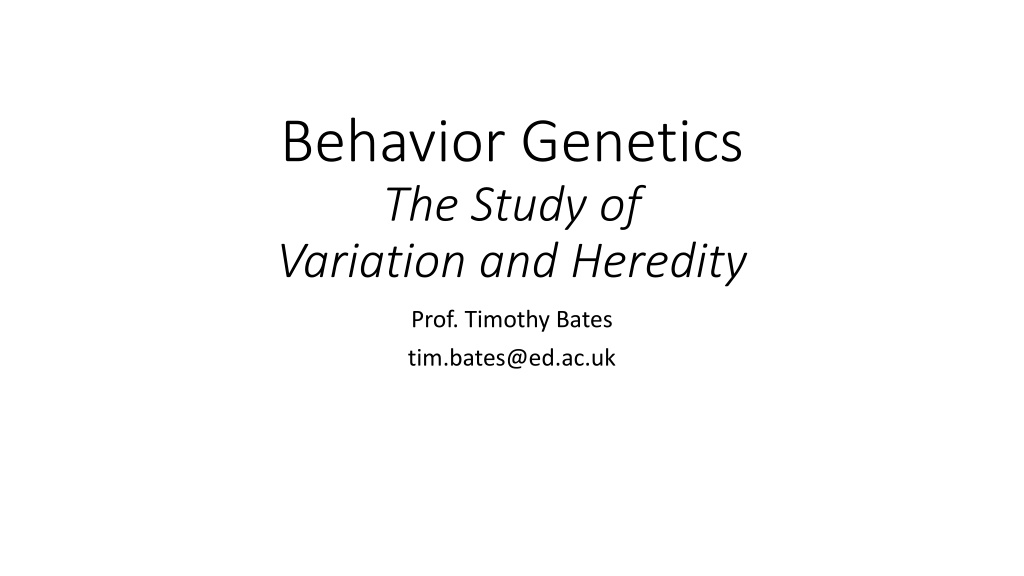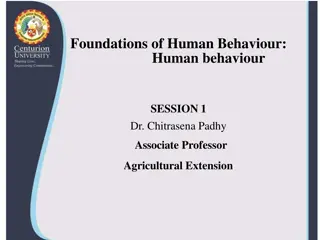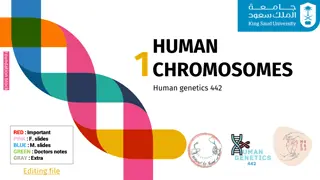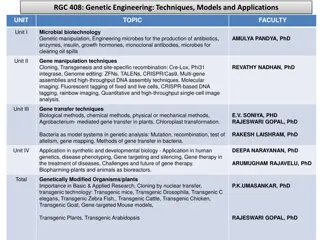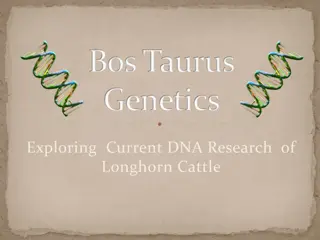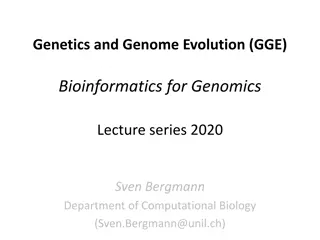Unraveling the Complexity of Behavior Genetics: Insights and Applications
Delve into the realm of behavior genetics with Prof. Timothy Bates, exploring methodologies like adoption, twin, and family studies. Discover the significance of genetic variance, correlation, and cognitive ability examples. Uncover how genetics untangles causality, why we exhibit variation, and the role of genes, environment, and intelligence. Gain insights into heritability estimation and genetic relatedness in behavioral genetics.
Download Presentation

Please find below an Image/Link to download the presentation.
The content on the website is provided AS IS for your information and personal use only. It may not be sold, licensed, or shared on other websites without obtaining consent from the author. Download presentation by click this link. If you encounter any issues during the download, it is possible that the publisher has removed the file from their server.
E N D
Presentation Transcript
Behavior Genetics The Study of Variation and Heredity Prof. Timothy Bates tim.bates@ed.ac.uk
Overview Introduce behavioural genetic methodology Adoption studies Twin studies Family studies Introduce concepts of Genetic variance Genetic correlation Examples of cognitive ability
Causality: genetics uniquely untangles causality Does Parental Neglect cause Anti-Social Behavior? Eaves et al., 2010
Why arent we all the same? 2 = variance Sum((x-mean)2) > 0
Applies to Continuous Variation
and to categorical variation: Thresholded Continuous trait
In BG, categories like depression are often viewed as thresholds on a liability scale
Why do things run in families? Shared genes + Shared environment
Genes, Environment and Intelligence Sir Francis Galton (Victorian polymath) Half cousin of Charles Darwin Genealogical studies of eminent families Hereditary Genius (1869) Intelligence is inherited "Twins have a special claim upon our attention; it is, that their history affords means of distinguishing between the effects of tendencies received at birth, and those that were imposed by the special circumstances of their after lives."
Behavioural Genetics Methods Use known genetic relatedness to estimate variability in a trait due to genes (heritability) Children share 50% of genes with each parent Identical twins share 100% Non-identical twins/siblings 50% Grandparents 25%, cousins 12.5% Unrelated people, no genetic sharing
Resemblance for Cognitive Ability in family members Behavioral Genetics (2016). Valerie S. Knopik, Jenae M. Neiderhiser, John C. DeFries, Robert Plomin
Estimating h2 from extended Pedigree Studies Components of genetic and environmental variance are estimated by univariate linear mixed models Luciano et al., (2010) Intelligence, 38: 304-313.
Estimating h2 from Adoption Studies If adopted offspring are more similar to biological than adoptive parent indicates genetic influence e.g., adoptees with schizophrenia show concordance rate of 12% with biological family members versus 3% with adoptive family members Example to the right is height MZ twin- pair members in Tom Bouchard s MISTRA study of twins reared apart
Similarity for cognitive ability across adoptive family classes
Estimating h2 from Twin Studies Compare trait similarity in identical and fraternal twins 1/250 births are identical twins 1/150 are fraternal twins
Twins Reared Apart Design MZs reared apart 2 = A+C+E cov= A (=h2) Modern example Tom Bouchard Minnesota Study of Twins Reared Apart (MISTRA)
Genes, Environment and IQ
The Classical Twin Design: Variance decomposition MZ: Monozygotic Share 100% of genes (A) Share family (C) Have unique experiences (E) 2 = A+ C + E rMZ = A + C rDZ = .5A + C DZ: Dizygotic Share (on average) 50% of genes (1/2 A) Share family (C) Have unique experiences (E) E = 1 rMZ A = 2 * (rMZ rDZ) C = 1 (A + E) Falconer s formula
Heritability The proportion (ratio) of population variance that can be attributed to genetic influences This genetic contribution usually represents the cumulative effects of many genes ( polygenic complex trait genetics ) additive genetic variance Narrow sense: observed total variance total genetic variance Broad sense: observed total variance
Genetic Variation Genetic additivity (A): Allelic effects sum within and across loci Genetic non-additivity 1: (Dominance): Interaction of the effects of alleles at a locus Not shared between parents and offspring Genetic non-additivity 2: (Epistasis) Interaction of the effects of alleles across loci
Scatterplot for age and sex corrected stature in DZ twins Scatterplot for corrected MZ stature 20 13 8 10 3 HTDEV2 HTDEV2 0 -2 r=0.924 r=0.535 -7 -10 -12 -20 -10 -5 0 5 10 -16 -11 -6 -1 4 9 14 HTDEV1 HTDEV1 Twin Modelling in SEM (Structural Equation Modelling) ACE model
Specifying the ACE model Use two groups: MZs (with A1 <-> A2 path = 1.0) DZs, with A1 <-> A2 path = .5
SEM for Twin Modelling OpenMx R package, on CRAN Open Source: http://openmx.ssri.psu.edu umx R package, on CRAN Open Source High-level assistance for twin and general modeling umxACE()
Specifying the ACE model in OpenMx
How heritable is height? library(umx) & umxACE() data(twinData); df = twinData selDVs = c("ht1", "ht2") mzData <- df[df$zygosity %in% "MZFF", ] dzData <- df[df$zygosity %in% "DZFF", ] m1 = umxACE(selDVs= selDVs, dzData= dzData, mzData= mzData)
ACE Model Assumptions Twins are ordinary folks Similar to singletons despite greater gestational difficulties No particular effects of growing up side by side No assortative mating MZ and DZ twins experience environmental influences equally
ACE Model Assumptions Genetic and environmental influences are independent and additive No gene-environment correlation Exposure to environmental conditions depends on an individual's genotype No gene-environment interaction Environmental exposure does not moderate effects of genes on behaviour
Genes, Environment and IQ Gene by environment interaction Heritability value can change depending on the group(s) measured e.g. Higher heritability in high SES vs low SES (near or below poverty line in the US) Turkheimer E et al. Psychological Science (2003) 623- 628 Bates T C et al. Psychological Science (2013) 2111- 2116
Genes, Environment and IQ Heritability generally increases with the age of the sample measured: ~0.30 in childhood to 0.50 in middle adulthood to 0.70 in old age Haworth et al. (2010) Mol Psychiatry, 15: 1112 1120.
More than one Trait rG rC 1 1 1 1 Traits covary We can explain association via: Additive genetic factors (rG) Shared environment (rC) Non-shared environment (rE) A1 A2 C2 C1 c11 a22 c22 a11 ADHD IQ e11 e22 e.g. Kuntsi et al. (2004) Am J Med Genet B, 124:41 1 1 E1 E2 rE
Cholesky Decomposition 1 1 1 1 C1 C2 A1 A2 c11 c22 a11 a22 Twin 1 Phenotype 2 Twin 1 Phenotype 1 e11 e22 1 1 E1 E2
Cholesky Decomposition 1 1 1 1 C1 C2 A1 A2 c21 c11 c22 a11 a21 a22 Twin 1 Phenotype 2 Twin 1 Phenotype 1 e11 e21 e22 1 1 E1 E2
Cholesky Decomposition 1/0.5 1 1/0.5 1 1 1 1 1 1 1 1 1 C1 C2 C1 A1 A2 C2 A1 A2 c21 c21 c11 c22 a11 a21 a22 c11 c22 a11 a21 a22 Twin 2 Phenotype 2 Twin 1 Phenotype 2 Twin 2 Phenotype 1 Twin 1 Phenotype 1 e11 e21 e22 e11 e21 e22 1 1 1 1 E1 E2 E1 E2
Genetic Correlation a21a11 2*(a21 rg= 2+a22 2) a11
rG vs. robserved If the rG = 1, the two sets of genes overlap completely If however a11 and a22 are near to zero, genes do not contribute (much) to the observed correlation The contribution to the observed correlation (phenotypic) is a function of rG andboth heritabilities
Proportion of rP due to additive genetics: ADHD and IQ rg 1 1 ( ) A1 A2 2*rg* ay 2 ax a2 x a2y rp IQ ADHD Genetic correlation between ADHD and IQ Heritability of IQ Phenotypic corr. ADHD & IQ Proportion of pheno.corr. due to genetic factors Heritability of ADHD
Multivariate Modelling Luciano et al., (2001). Behavior Genetics, 31(6), 581-592.
(Many) Other important Types of Models Common Pathway Model Independent Pathways Model Longitudinal Data Latent Growth models Latent Factor models Interaction models G*E Measured Environment, Measured Genes Direction of Causation
Latent Growth Model 1 1 1 1 1 1 G1 AI a11 CI EI As a22 Cs Es e11 c11 e22 c22 G2 e21 c21 Genotypes a21 Bi Bs Intercept Slope im sm G3 Phenotype 1 0 2 1 1 1 Phenotype 1 Time 1 Phenotype 1 Time 2 Phenotype 1 Time 3 Twin 1 as33 as11 as22 es22 es11 es33 cs11 cs33 cs22 AS3 CS3 AS1 CS1 AS2 CS2 ES3 ES1 ES2 1 1 1 1 1 1 1 1 1 Age
Quantitative and Qualitative Sex Effects Females Does the magnitude of genetic/environmental effects differ in males and females? (QUANTITATIVE) With OS pairs: Are the same genes/environments acting in males and females (QUALITATIVE) Compare correlations from DZ like-sex DZ opposite-sex pairs Sex-specific effects suggested when OS DZr < Same-sex DZr. 1.0 (MZ) / .5 (DZ) 1.0 A1 C1 E1 A2 C2 E2 cF cF aF aF eF eF P1 P2 aF = aM? cF = cM? eF = eM?
Bivariate Direction of Causation Modelling
Extending theTwin Design Adding other relatives Siblings Cousins Children of twins Parents, grandparents Uncles, Aunts
Thank you! Questions Please!
